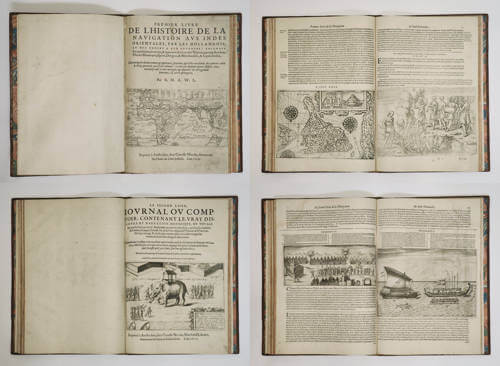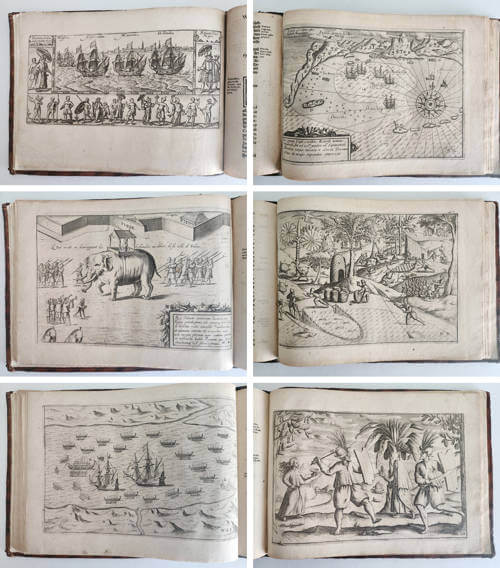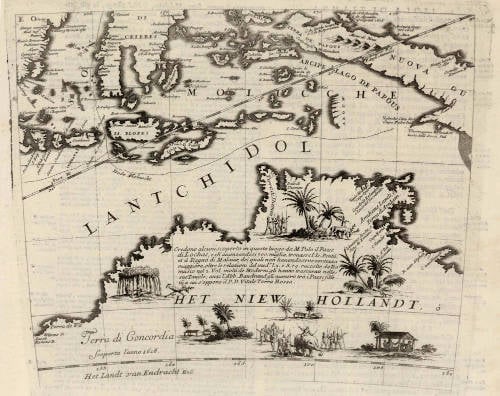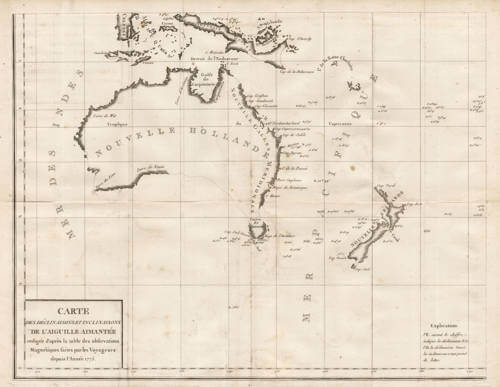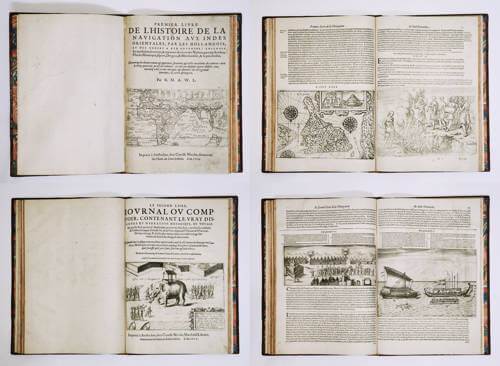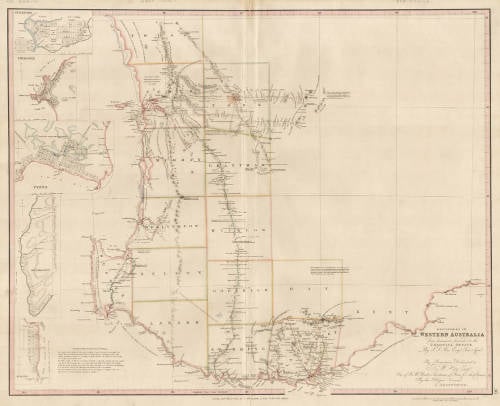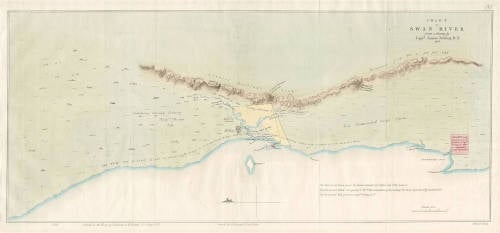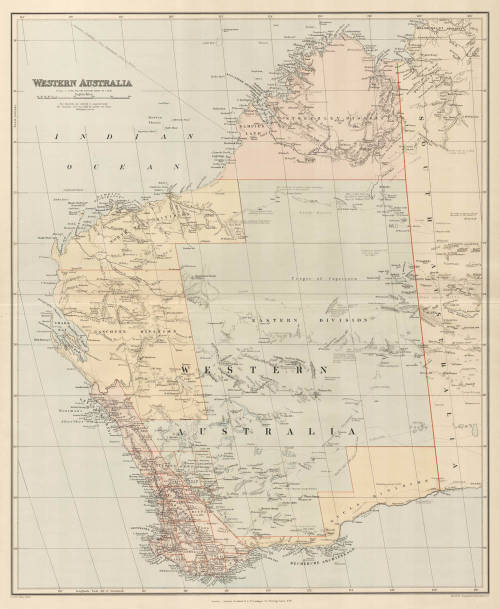Leen Helmink Antique Maps
Jacob van Neck's Journal of the Dutch second fleet to the East Indies, here in 1646 Commelin edition
Stock number: 19415
Image GalleryCartographer(s)
Jacob van Neck (biography)
Title
Waerachtigh verhael van de Schipvaerd op Oost-Indien ghedaen
First Published
Amsterdam, 1602
This Edition
1646 Amsterdam edition
Technique
Condition
Fine
Price
$ 4,500.00
(Convert price to other currencies)
Description
Admiral Jacob van Neck's ship's journal of the 1598-1599/1600 Dutch second fleet to the Indies.
The book famously has the first engraving of a Dodo bird and the first maps of the legendary Spice Islands. The book was first published in 1602, here offered in the 1646 re-issue. Curiously, this edition has a title page that depicts the departure from Amsterdam harbour of the 1595-97 Dutch first fleet of the Indies, including the yacht Duyfken, the very pinnacle that would discover Australia in 1606.
The journal ends with an eleven page dictionary of Malay and Javanese words.
Condition
Original contemporary calf binding. A near flawless copy, no restorations or imperfections, complete, in very fine condition.
Enter the Dutch
The dreams and labours of Petrus Plancius and Jan Huyghen van Linschoten culminated in the Dutch First Fleet to the Indies taking place from 1595 to 1597. It was instrumental in the opening up of the Indonesian spice trade to the merchants that would soon form the United Dutch East India Company (VOC).
While the first fleet was not a commercial success, it demonstrated that the Spanish/Portuguese Empire and it's monopoly on overseas trade was vulnerable and could be circumvented.
Shortly after the first fleet, Dutch merchants immediately organized a second fleet using venture capitalist funding, and this fleet reached the Moluccas to buy spices directly and to establish trade relations there. The fleet was much larger than the first fleet, and the journals contained the first detailed maps and views of the spice islands.
This famous fleet would abruptly end the Portuguese Empire's trade monopoly for the East and it would dramatically change the Indian Ocean theatre, notably the balance of power and the rules of trade. Right from the first and second fleets onward, the Dutch were going to dominate the East Indies and its trade for more than 350 years.
The voyage is of seminal importance to the exploration and the cartography of the region.
The Second Voyage (1598-1600) by the Dutch to the East Indies
Despite its achievements, De Houtman's voyage did not live up to all of the commercial expectations. Even so, this voyage was a major stimulus to new expeditions to the East Indies. The fact was that the Cape route had been explored and the Indian Ocean lay open to the enterprising spirit of Holland and Zeeland. On the De Houtman voyage, the men had observed at first-hand the absence of the Portuguese fleet from the East Indian waters. During their stay on the coasts of Java, they had not seen a single Portuguese ship. In Amsterdam and Zeeland, it was realized that the Portuguese forces had been weakened to such an extent that a repetition of the first attempt had good chances of success - assuming they would not repeat the mistakes made on the first voyage. In 1598, in various cities of the Northern Netherlands, new fleets were fitted out to sail to the East Indies. The most important one was the fleet consisting of eight vessels under Admiral Jacob Cornelisz van Neck (1564-1638) and Vice-Admiral Wijbrant Warwijck (1570-?). The crew consisted of 560 men, including the merchant officer Jacob van Heemskerck, who had only been back from the winter ordeal on Novaya Zemlya for half a year. Van Neck's voyage was very important, because it was the first time that Dutch ships appeared in the waters of the eastern archipelago, around the Moluccan Islands. Moreover, by establishing lodges, the basis was laid for Dutch trade and the later settlement to be established in these areas.
Van Neck's fleet left its anchorage at Texel on 1 May 1598. Till the Cape of Good Hope, the voyage proceeded without any unusual incidents. But then, on 8 August, about 50 miles past Cape Agulhas, the vessels became separated in a heavy storm. Admiral Van Neck continued the journey with three ships, taking on fresh supplies on the island of S. Maria off the eastern coast of Madagascar and in the Bay of Antongil. Finally, on 26 November, his ships reached the roadstead of Bantam. Vice-Admiral Warwijck met up with him there five weeks later with the five ships that had strayed off. Warwijck had also spent a few days on the south coast of Madagascar, but he could not land there because of the heavy surf. It was then decided to sail directly to Java without taking on fresh supplies. In so doing, they took a great risk, but fortunately, on 17 September, the squadron sighted Ilha do Cerne, one of the Mascarene islands. They named the island Mauritius de Nassau, in honour of Prince Maurits. On the south side of that island, they found an excellent protected harbour, to which they gave the name Warwijck-haven, while the island lying at the entrance to the harbour was named Heemskerck-eiland. The men stayed on this deserted island for two weeks to allow those crewmembers suffering from scurvy to recuperate. On 2 October, they again set sail on a course toward Bantam, where they arrived on 31 December 1598.
In the meantime, Van Neck had already purchased a large amount of spices, enough to fill four ships. With these four (Mauritius, Hollandia, Vriesland, and Overijssel), Van Neck embarked on the homeward journey on 11 January 1599, while Warwijck was sent to the Moluccas with the other ships. Van Neck's voyage home went well; they only stopped at S. Helena to replenish the stocks and rest the men for a few days. On 19 July, the ships dropped anchor at Texel, and just over a week later Van Neck received a festive welcome in Amsterdam, where people were happy with the safe return of the ships and the rich cargo of pepper, cloves, mace, nutmeg, and cinnamon that they had brought with them. The whole journey had lasted not even 15 months. It had been so quick that the Portuguese living in Amsterdam did not believe that Van Neck had really been in the East Indies at all; they 'said that the goods had been stolen half way'.
What had happened to the other ships in the meantime? In Bantam, on 4 January 1599, the General Council had decided that Warwijck, commanding four ships (Amsterdam, Zeeland, Gelderland, and Utrecht), would sail to the Moluccan Islands. He was to bear the title of admiral, while Jacob van Heemskerck was appointed vice-admiral. On 9 January, the squadron left the anchorage at Bantam. They sailed via Jakarta, Tuban, and Grissee on the coast of Java to Arosbaja on Madura. On 14 February, they continued their voyage, and on 3 March they dropped anchor at Hitoe on Ambon. There, the supply of spices proved to be insufficient. Thus, Warwijck, in turn, sent Van Heemskerck with the Zeeland and the Gelderland on to Banda to obtain a cargo. There, the trading negotiations went so smoothly that Van Heemskerck could already start the voyage home at the beginning of July, carrying a rich cargo of nutmeg. He established the first lodge of the Dutch in the Moluccas, leaving 20 men behind with commercial appointments and money so they could already buy nutmeg and mace for subsequent Dutch ships. Five months after leaving Banda, Van Heemskerck's ships lay at anchor at S. Helena to take on supplies. On 1 January 1600, they continued their voyage, and at the end of April the ships arrived safely at Texel.
On Ambon, Admiral Warwijck could only obtain a small cargo. Therefore, on 8 May, after a stay of two months, he decided to sail on to Ternate, which he reached on the 23rd. There, they loaded as much cloves as they could purchase and started the homeward journey on 19 August. Six men were left behind for the sake of future commercial relations. On the return trip, they stopped again at Bantam on 17 November to supplement the cargo. On 21 January 1600, they resumed their voyage. The presence of Portuguese ships at S. Helena prevented them from landing there, and later, on Ascension Island, they were only able to obtain a small amount of fresh food. Thus, scurvy cropped up on the ships. Finally, Warwijck reached the anchorage at Texel at the beginning of September 1600.
All eight ships of the Second Voyage had returned safely and brought the shipowners great profits. An important result was that the Hollanders had found and explored the route to the Moluccas themselves, and consequently they no longer had do deal through Portuguese intermediaries.
In 1599, soon after Admiral Van Neck returned with four ships, a description of his voyage was published. Although not a single copy of that work has been preserved, the existence of that publication was confirmed by Emanuel van Meteren. In the very same year, an English translation appeared in London. Then, in 1600, after the remaining four ships had also returned, a report was published describing the adventures of the entire expedition. The report, entitled Journael ofte Dagh-register, was published in Middelburg by Barent Langenes and in Amsterdam by Cornelis Claesz. An English translation of that work was published in London in 1601. However, the Amsterdam edition of 1600 was already replaced in 1601 by a more extensive Tweede Boeck, which formed the basis for all subsequent editions and translations.
(Schilder)
Jacob van Neck (1564-1638)
Jacob Corneliszoon van Neck (often anglicized to Jacob Cornelius van Neck) (1564 – March 8, 1638) was a Dutch naval officer and explorer who led the second Dutch expedition to Indonesia from 1598 to 1599.
Van Neck was from an Amsterdam family in good standing, and received a thorough education. Since he came from a commercial background and was not experienced in sailing, he took extra classes in navigation.
Following the success of the first Dutch expedition to Indonesia in 1597, Van Neck was chosen to lead a second expedition in 1598, with the purpose of bringing back various spices. In May 1598, he left the port of Texel with eight vessels under his command.
He was accompanied by Vice-Admiral Wybrand van Warwyck and noted polar explorer Jacob van Heemskerk.
Following sailing directions written by Petrus Plancius, they made excellent progress, reaching the Cape of Good Hope in only three months.
Soon after this, heavy storms separated Van Neck, with three ships, from the rest of the fleet under Warwyck. Neck landed on the east coast of Madagascar and replenished his supplies, then continued on towards the Indonesian city of Bantam. He reached it on November 25, 1598, after less than seven months of sailing. Within one month, all three of his ships had been filled with spice, and on December 31 the other half of the fleet sailed into port at Bantam, prompting a huge New Year's celebration. Van Neck filled one more ship full of spices, making four ready to be sailed back to Amsterdam, then sent Warwyck and Heemskerck with the other four ships to the east in order to procure more spices. Van Neck then took the four ships that had been loaded with spices back to Amsterdam, where he arrived July, 1599.
He brought back with him nearly one million pounds in weight of pepper and cloves, in addition to half a ship full of nutmeg, mace, and cinnamon. The explorers were greeted by an ecstatic Amsterdam and paraded through the city behind a band of trumpeters, with every church bell tolling. The merchants who had backed the voyage rewarded Van Neck with a gold beaker (it later turned out to be only gold-plated) and the crew were given as much wine as they could drink.
The voyage was a tremendous success, earning the backers a 400 percent return on their investment.
Van Neck made one more expedition to the Indies after his voyage of 1598, losing three fingers while doing battle with a Spanish-Portuguese fleet near Ternate. He retired from exploring after that, and later became a mayor of Amsterdam, and alderman, and a member of two admiralty colleges. He died on March 8, 1638.
(Wikipedia)
Related Categories
Related Items
